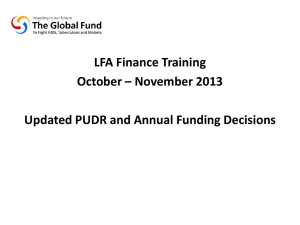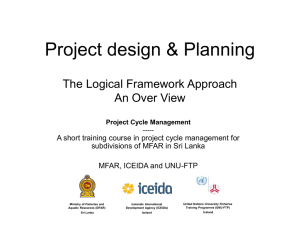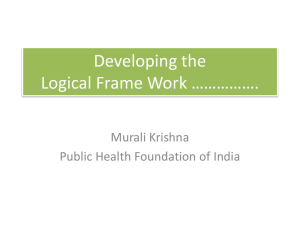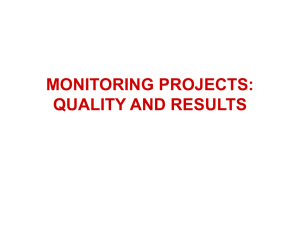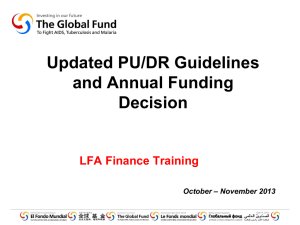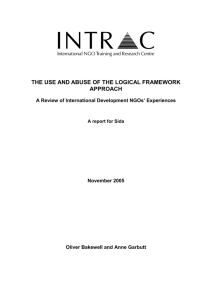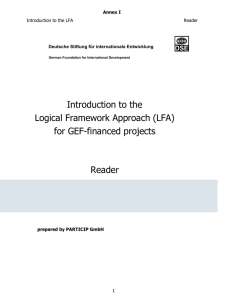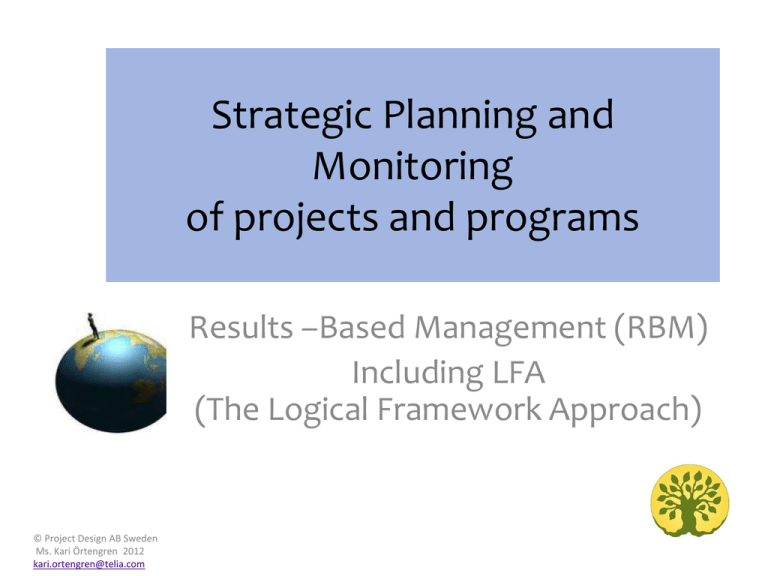
Strategic Planning and
Monitoring
of projects and programs
Results –Based Management (RBM)
Including LFA
(The Logical Framework Approach)
© Project Design AB Sweden
Ms. Kari Örtengren 2012
kari.ortengren@telia.com
Which way is the best way?
Purpose of this seminar
• Increased knowledge on a strategic tool for
planning, the LFA-method
• Tool to use in change projects
• Improved strategic planning of change
projects
• Long –term objective: To contribute to
strengthen the results of your change
projects, sustainable effects
© Project Design AB Sweden
K. Örtengren 2012
Planning well is crucial
to reach results
Thera are many different
tools for planning
Many different supporting methods
to be used
in RBM
•
•
•
•
•
•
ROPS
Balanced scorecard
SWOT analysis
PROPS
Lean
The LFA method (the Logical Framework Approach)
Methods with different purposes
- for planning or monitoring
Participatory approach
Results-Based Management (RBM)A Management Strategy
RBM in brief, a management strategy:
o To manage the whole project cycle in a professional way
o To plan correctly, with SMART objectives
o Monitoring continuously - collecting data
o Assessing/analysing results
o Learning from results
o Disseminating results
o Managing and acting upon results
o Institutional learning to become better
Project Cycle Management
LFA
The Logical Framework Approach
an efficient tool for planning
Result - Oriented
Strategic Planning
LFA HISTORY
LFA was developed in the 1960s
The method is in use world wide, by all international
development organizations when assessing, monitoring and
evaluating projects and programs.
The UN-system, EU, multilateral and bilateral development
agencies all act to have their counterparts to use result
oriented planning, the LFA method, when planning,
implementing and evaluating projects and programs.
Why LFA?
By using the LFA-method correctly the
project/program reaches;
RELEVANCE
FEASIBILITY
SUSTAINABILITY
COST EFFECIENCY
The nine steps of an LFA
analysis- the planning process
•
•
•
•
•
•
•
•
•
1. Analysis of project´s Context
2. Analysis of Stakeholders
3. Problem Analysis/Situation Analysis
4. Objectives Analysis
5. Plan of Activities
6. Plan of Resources/Inputs
7. Indicators and Source of Verification
8. Risk Analysis and Risk Management
9. Analysis of Assumptions
Step 1
Context Analysis
Background
Collect background information
Step 1. Context Analysis
Background information
• Projects are part of a larger context - prior to start, collect
relevant background information on the sector and on the
relevant organizations to work with.
• Which environment will the project be situated in,
the country, the region and the sector?
• Analysis of Context is made through studies
(sector-, country- and /or regional studies etc.)
Step 2
Stakeholder Analysis
People with different knowledge, different
background, different sex, different region
Listen and involve
© Project Design AB
Kari Örtengren / 2012
kari.ortengren@telia.com
Mobil: 0733-795 568
www.kariortengren.se
Step 2. Stakeholder Analysis
• Stakeholders, those who are influenced by and exert an
influence on the project entity. Who will be influenced,
positively or negatively, by the project.
• Stakeholder analysis - mapping of stakeholders and their
respective roles, include gender, age, ethnic, regional and
aspects of experience!
• Which stakeholders should be involved in planning and /
or implementing the project – important to include a
broad group – people with different knowledge on the
sector!
© Project Design AB Sweden
K. Örtengren 2011
Step 2
Stakeholder Analysis
Five main groups of stakeholders to involve:
Beneficiaries/Target group
Implementers
Financing agents
Decision makers
Experts
One stakeholder may belong to several groups. The stakeholders all have
important information to give to the future project group/ implementers.
They provide a relevant picture of the situation in order to find relevant,
feasible and sustainable solutions.
© Project Design AB Sweden
K. Örtengren 2011
Step 3
Problem Analysis
Situation Analysis
Effects
Focal Problems
Causes
How to involve stakeholders
and get an understanding of the situation
© Project Design AB
Kari Örtengren / 2012
kari.ortengren@telia.com
Mobil: 0733-795 568
Step 3. Problem Analysis
Situation Analysis
• Problem analysis is helping us finding “the roots of the
evil”
• Three parts in a problem analysis;
The main problem to be solved, one focus
The causes, reasons to the focal problem
The effects of the focal problem
• Discuss who owns the problem?
• A problem analysis should always be made by the local
stakeholders, the owners of the problem.
PROBLEM TREE
Effekr
Effects
Focal Problem
Causes
EXAMPLE on a
PROBLEM TREE
Bus company gets a
bad reputation
Effekr
Disabled
people
High cost for
hospital care
People die and
get injured
Buses
are delayed
High number of
bus accidents
Careless
busdrivers
Stress
Bad traffic
situation
Buses in
poor condition
Alcohol
abuse
Tight
schedule
Poor
maintenance Old buses
No maintenance
routines
Too few drivers
and buses
Weak management capacity
at the bus company
Roads in
poor condition
Poor maintenace
Weak
knowledge
on manintenace
Corruption
Step 4
Objective Analysis
Formulating Objectives
Three/four levels of objectives
© Project Design AB
Kari Örtengren / 2012
kari.ortengren@telia.com
Mobil: 0733-795 568
Why a Problem Tree?
Problem Tree
Effects
Objective Tree
Overall objectives
Focal problem
Project Objective
Causes
Expected results
Activities
Objectives vs. Activities
There is a difference between objectives and activities.
Objectives should describe;
Which is the changed situation to acheive
What to acheive when the project is completed.
What the activities are aiming at
Whlle, an activity is a mean to acheive the objective
Example on an objective:
Enhanced competence on trade facilitation
among ITP participants
Example on an activity:
Arrange a seminar on trade facilitation
Step 4. Objectives Analysis
Three levels
1. Long-term: Overall Objectives, Development Objectives: Often
Governmental level, long term perspective, vision e.g. social welfare, economic
growth... Time frame: Long term. Several different projects often aiming at the
same overall objectives. Sometimes also called goals.
2. Medium-term: Project Objective, Project Purpose : The main
objective that the intervention/project should be able to achieve. Solution to
the focal problem. The very reason for implementing a project. Time frame:
Medium term (the length of the project). Purpose should be “SMART (Specific,
Measurable, Approved, Realistic and Time-Bound”)
3. Short-term: Expected results, immediate objectives: The results
describe the services to be produced by the project. What services do the
beneficiary get access to? Short term objectives. Directly after the project
activities. Time frame: After the activities have been implemented. Results
should be “SMART”.
Make it logic when planning, Example
Overall objectives:
The project will contribute to increased trade and
increased GDP in country X
Project objective:
Increased efficiency in the customs service in country X
Expected results:
1. Enhanced competence on custom related trade
facilitation mesures among customs service staff
2. Strengthened management capacity in the
Customs service
3. Improved customs clearence routines
Expected Outputs:
1. 500 staff members trained on trade facilitation
3. New manuals for customs clearance developed
© Project Design AB
K. Örtengren 2012
Activities: Ex. some activities
1.1 Develop a training , 1.2 Implemeted a pilot training
for 20 staff , 1.3 Evaluate the training
“SMART” project objective
& results (short-term objectives)
• Specific
• Measurable
• Approved
• Realistic
• Time bound
Writing objective statements
Objective hierachy
Overall objectives
Example of how to write objectives
To contribute to increased GDP in country X
--------------------------------Project objective
(mid-term):
---------------------------------Expected Results:
------------------------
Improved service from the state sector to
exporting companies in country X
---------------------------------------
1.Enhanced knowledge among officials on Trade
facilitation and Rules of Origin
2. Improved trade standards
established and effectively enforced in the
country.
-------------------------------------
(long term)
(Short term objectives)
------------------------------Activities:
Activities for expected result 1:
1:1 Conduct a baseline survey of the vocational training and a need
assessment (knowledge gaps)
1:2 Analyse the findings of the study
1:3 Make a curriculum for trainings based on the findings
1:3 Prepare tender documents for new training programs
1.4 Select trainers /providers of the vocational trainings
1:5 Implement pilot trainings
1.6 Follow-up /monitor of the trainings , analyze results and
if needed change the trainings
1:7 Run a full scale training program for health care staff
1:8 Evaluate the program after 3 years, and analyze, if needd repeat
part of the training program
Different terminology for objectives used by
different projects
and donors, choose what’s best for you
Objectives
Think of the
time – line,
the logic
DFID
Long-term
objectives
Goals
Overall
Objectives
Impact
Impacts/
Development
Objectives
Medium-term
objective
Project
Purpose
Project
Objective
Outcome
Project
Outcome
Short-term
Objectives
Immediate
objectives
Expected
Results
Outputs
Intermediate
Outcomes
EU
(Great Britain)
© Project Design AB Sweden
K. Örtengren 2010
RBM
World Bank
(ResultsBased
Management)
Terminology differs, depends on the project owners
When selecting objectives,
bear in mind…
• “SMART” objectives (Specific, Measureable,
Approved, Realistic and Time bound)
o Mandate of your Ministry/agency/NGO
o The resources available for implementation
o The problem to be solved (study the problem
analysis, see step 3 in LFA)
o The target group
o Diplomacy
© Project Design AB Sweden
K. Örtengren 2012
Step 5
Plan of Activities
Plan of Operation
© Project Design AB
Kari Örtengren / 2012
kari.ortengren@telia.com
Mobil: 0733-795 568
Step 5. Activities/ Plan of Operation/
Plan of Activities
• Activities are means to achieve the objectives,
not the objectives. Activities tackle the causes to
the focal problem (see problem analysis, step 3)
• Activities should be clearly specified and
expressed as an action. They explain how to
achieve the expected results of the project (the
short term objectives).
• Activities should be connected to the expected
results , the short-term objectives
(Expected result 1: activities 1:1,1:2, 1:3… etc.)
© Project Design AB Sweden
K. Örtengren 2012
Step 5. Activities/ Plan of Operation/
Plan of Activities
Activities should always be connected to the expected results/short-term objectives e.g.
Result 1: Improved knowledge among decision-makers at ministerial level on
efficient trade facilitation measures
Activity: 1:1 Make a need assessment among staff in Ministries and relevant authorities
1:2 Develop a training program, a curricula, and training material for trainings
1:3 Print training material
1:4 Train 15 teachers/trainers (ToT )
1:5 Implement the training program for 25 persons, a pilot training
1:6 Follow-up of the training program, review evaluations, if needed make
changes in the training curricula
1:7 Complete the training program
1:8 Evaluation and dissemination of the results of the trainings
1:9 Integrate the program in to existing services
Specified plans of activities make it easier to implement, to monitor
and much easier to make a realistic planning of resources
(budget, manning schedule and time schedule etc.) .
© Project Design AB /Sweden
K. Örtengren 2012
Step 6
Planning of Resources
Staff
Budget
Equipment
Time
© Project Design AB
Kari Örtengren / 2012
kari.ortengren@telia.com
Mobil: 0733-795 568
Step 6. Inputs/Resource
planning
• Experts and personnel (human resource management, project group,
reference group, which knowledge & capacity is needed?)
• Financing (loans, grants, funds, cost sharing, who is financing what?
Future long term financing?)
• Equipment, equipment should be adapted to local conditions
(Are spare parts and maintenance available?)
• Premises (office, training facilities, is there a contract for the premises?)
• Time (make a realistic time schedule, e.g. GANTT-schedule)
© Project Design AB Sweden
K. Örtengren 2011
Example GANTT schedule
Time Schedule / Gantt Chart
Microsoft Project Professional
Step 7
Indicators &
Sources of verifications
To monitor results
© Project Design AB
Kari Örtengren / 2012
kari.ortengren@telia.com
Mobil: 0733-795 568
Step 7. Indicators
Measure achievements
• Are the objectives achieved? Any positive results?
• The process of setting up indicators shows whether
the objectives are vague and unrealistic.
• Indicators should be set for all expected results and for the
project purpose (short-term objectives and medium-term
objective).
• Indicators should state the quantity and the quality
© Project Design AB Sweden
K. Örtengren 2012
Examples of indicators, quantity and/or quality,
Indicators for a management training e.g.:
1. Number of persons participating in the training
(SoV: List of participation) (quantity)
2. Number of occasions when knowledge among the trained
personnel has been used
(Source of verification (SoV): Number, interviews) (quality)
3. Number of persons passing the test after the training
(SoV: The test results from the training)
4. Examples of changes made in the organization after the training
(SoV: Organizational study )
5. Staff recognition/comments 6 months after the management
training ( SoV: Interviewing staff on management at the authority)
Indicator for service: e.g. Number of satisfied customers (SoV:
statistics, interviews %) (measures quality).
Step 7. Indicators
Measure achievements
• A baseline study, input data is needed, in order to be able to
measure the final results, to be able to compare.
(E.g. how many custom clearances per year when we start our
project)
• Each indicator should be connected to a Source of Verification
(SoV), answering the questions how the information on the
indicator should be collected, when/how it will be collected
(e.g. SoVs interviews, exams, at the statistical office,
questionnaires etc.)
Step 8
Risk Analysis and Risk Management
Continuous risk analysis
& risk management
important to reach sustainability
Step 8. Risk Analysis &
Risk Management
• Analysis of factors which may influence the
implementation of the project and hence the
achievement of the objectives.
• Internal and External risks
• Make a risk management plan – mitigation of
risks, new activities.
• Killing factors? Important threats, threatening the whole
implementation e.g. the political situation, corruption etc.
© Project Design AB Sweden
K. Örtengren 2011
Risk value
Risks
1.Brain-drain
Probability
1-5
Consequence
1-5
5
4
Risk value
Risk
management
/mitigation
20
a.
b.
c.
d.
2.Delayed
deliveries
2
1
2
Train more staff
Develop manuals for
training
Develop an internal
long term training
module
Avoid dependence
on one person, share
responsabilities
None
Step 9
Analysis of Assumptions
Important problems to be solved by others
Step 9. Analysis of
Assumptions
• Assumptions describe situations and conditions which are
necessary for project success, problems needed to be
solved, but which are largely beyond the control of the
project group to solve (due to the resources of the project
group, their mandate and knowledge etc.)
• An assumption, is a problem the project group realistically
can assume that other projects/ authorities/actors will handle
Why different steps in LFA
in the planning procedure?
• Relevance Step 1 – 4
The Context, the Stakeholder-, the
Problem- and the Objectives analysis. Logical links between problems and
solutions? Ensure that the problems of the target group are solved by the
project.
• Feasible Step 5 – 7
Plan of Activities, Resources/inputs and
Indicators. Are the activities and resources sufficient to achieve the
objectives? (Resources: Personnel, time, funding, equipment)
• Sustainable Step 8 – 9 Risk analysis, Risk Management and
Analysis of the Assumptions. If the project is sustainable, will the effects
of the project remain without external assistance?
The nine steps of an LFA
analysis - why?
1. Analysis of project´s Context
2. Analysis of Stakeholders
3. Problem Analysis/Situation Analysis
4. Objectives Analysis
6. Plan of Resources/Inputs
5. Plan of Activities
7. Indicators/measurements
8. Risk Analysis and Risk Management
9. Analysis of Assumptions
RELEVANCE
FEASIBILITY
SUSTAINABILITY
GROUP ACTIVITY
1.
PROBLEM: Identify one focal problem, e.g. You decided, but some
proposals
a) Weak efficiency in the customs service
b) Little knowledge in the trade sector on rules of origin (RoO)
c) Weak support from the state to the export industry
2.
STAKEHOLDER ANALYSIS: Identify stakeholders in the sector
(Beneficiaries/target group, Implementers, local financing agents, decision makers)
List them.
3.
PROBLEM ANALYSIS: Identify reasons/causes to the focal problem
and effects. Make a brief problem tree, write notes.
4.
OBJECTIVES: Set at least two expected results (short-term objectives),
one project objective and two overall objectives. Formulate them
“SMART” .
5.
ACTIVITIES: Find solutions/activities to achieve result 1-3.
Number the activities (1:1, 1:2, 1;3 etc.) and connect them to each
expected result.
LFA matrix / Log Frame –
a way to summarize a project plan
Overall
Objectives
Indicators
Sources of
Verifications
Indicators
Sources of
Verifications
Assumptions
Expected Results Indicators
Sources of
Verifications
Assumptions
Project Purpose
Activities
© Project Design AB Sweden
K. Örtengren 2008
Resources
Preconditions
INTERVIEWS and/or WORKSHOPS
Participatory approach
© Project Design AB Sweden ,
Ms K. Örtengren 2010
Two main types of project
planning workshops
1.Initial planning workshop
(GOPP or LFA workshop. WHY a project ? and WHAT a project aims
at?). Initial workshop is step I. Enhances engagement from a broad
group of stakeholders – facilitates the future planning and
implementation, listen to stakeholders! Participatory approach!
Report after workshop handed over to the project management team.
2. Management workshop
(HOW a project should be implemented, details ), detailed planning,
specification. Planning meetings for the project management team.
© Project Design AB Sweden
K. Örtengren 2011
LFA steps in an LFA workshop
STAKEHOLDER ANALYSIS
PROBLEM ANALYSIS!!
ANALYSIS of OBJECTIVES (proposal)
OVERALL ACTIVITY PLANNING (proposal)
RISK ANALYSIS (overall , proposal)
(ANALYSIS of ASSUMPTIONS, proposal)
Proposals from the stakeholders to
the project group
LFA/GOPP WORKSHOP answers WHY a project and WHAT
a project will handle, not HOW
© Project Design AB Sweden
K. Örtengren 2010
LFA summary
Project Planning
• Structured the project planning procedure in 9 steps
• Relevant, Feasible and Sustainable projects/programs – leads
to success!
• Involve local stakeholders – listen to the target group
• LFA correctly used, strengthen local participation
& local ownership!
• Connection problems and objectives – relevant solutions
• LFA during all phases of the project cycle, LFA planning
sets the basis for efficient monitoring
How the LFA method works
depends on its users
BRIEF on MONITORING
© Project Design AB Sweden
K. Örtengren 2010
STEPS in MONITORING/
FOLLOW-UP of a PROJECT
CONTINUOUS MONITORING of OBJECTIVES
(monitoring means using indicators & sources of verifications)
ANNUAL PROGESS or INTERIM REPORTS
ANNUAL REVIEW MEETINGS
ANNUAL WORK PLANS
FINANCIAL REPORTS
COMPLETION or FINAL REPORT
AUDIT
FOLLOW –UP MEETINGS WITH STAKEHOLDERS (incl. target group)
Narrative reporting and financial reporting
Every step in monitoring needs efficient planning
MONITORING PLAN!
Make a monitoring plan for your project
by deciding :
WHAT
to monitor (which objectives does your project have )
HOW to monitor (Define Indicators & Sources of Verifications,
SoVs such as interviews, studies, tests etc.)
WHO
will collect the data (disseminate responsibilities
for monitoring)
WHEN
to monitor (when will you collect the data/the results)
COMMUNICATION PLAN
Make a communication plan for your organisation to
disseminate results to efficiently recieve sustainable
results,
Communication plan by defining the following:
WHO will/should receive the data on the results from
the project, who needs it
WHY communicate to different stakeholders,
the purpose with the communication
WHICH data is needed for different stakeholders
HOW to disseminate/communicate results
WHEN to disseminate data
LFA & RBM TERMINOLOGY
TERMIOLOGY FOR PLANNING & MONITORING
LFA terminology use when planning
RBM terminology , use when
measuring performance, during
implementation and evaluation
OVERALL OBJECTIVES
(long-term)
IMPACT
PROJECT OBJECTIVE
(medium-term)
MEDIUM-TERM OUTCOME
•
EXPECTED RESULTS
(short-term)
SHORT-TERM OUTCOMES
EXPECTED OUTPUTS
OUTPUTS
(direct result from activities)
RESOURCES
INPUTS
LEVELS of MONITORING
TERMIOLOGY IN MONITORING
1. IMPACT
1. Long term effects on life changes
2. MEDIUM-TERM
OUTCOME
(project objective)
2. Medium term effects- access usage and
3. SHORT-TERM
OUTCOMES
3. Short term effects, services produced (e.g. a.
4. OUTPUTS
4. Very short-term results, direct effect of the
(Overall objectives)
(expected results)
5. INPUTS
and living standards (e.g. Increased trade and/or
improved GDP)
satisfaction of users
(E.g. Improved Efficiency in Customs Service in
region X )
Improved technical administrative solutions in
custom service in region X,
b. Strengthened knowledge among administrative
staff in Customs Service in Region X )
activities, such as 150 staff trained, 20.000
manuals printed etc.
5. Financial, staff, time input needed to implement
project (e.g. 200 USD, 45 man months and 3 years)
Capacity development
To achieve sustainable results, analyse capacity
development needs at different levels in the society.
© Project Design AB
Sweden
K. Örtengren 2011
Kari.ortengren2telia.com
Capacity Building
Contextual
analysis
Institutional framework
System of organizations
Organization
Unit within organiz.
Individual/
Profession
(competence)
To ensure sustainabilityMake an Exit Strategy /Continous Risk Management
1.
2.
3.
4.
5.
To reach sustainable results, important factors to plan for at an early
stage (to make a risk management plan regarding):
Local Capacity for ownership of the process, depends on:
a. Knowledge among staff
b. Willingness to change
c. Participation and responsibility
d. Future financing, long term financing
e. Available time
Methods for implementation of the project, have to be adapted to
local conditions, to cultural-, instititutional- and to gender aspects,
age and capacity.
The distribution/dissemination of the knowledge needs to be efficient
within the organisation and to other organisations and regions.
Political will and political awareness on the issue.
Legislation and regulations
Monitoring and Evaluation
Monitoring: the systematic and continuous assessment of
progress over time by collecting and analysing information, and
using that information to improve the project’s work. The periodic
measurement of progress of a program/project . Monitoring focus on:
Project/program implementation process, tracking progress towards a
predetermined set of objectives, by using indicators and sources of
verifications.
Evaluation: the assessment at one point in time of the impact of
a project and the extent to which objectives have been achieved.
Both are tools for identifying strengths and weaknesses and for
making good and timely decisions to reach progress.
Evaluation Criteria
Relevance: The appropriateness of the project objectives to the problems
it addresses and to the physical and policy environment.
Efficiency: Results acheived at reasonable cost i.e how well inputs/means
have been converted into results in terms of quality, quantity and time?
Effectiveness: An assessment of the contribution made by the results to
achievement of the project purpose and how assumptions have affected
project achievements.
Impact: The effect of the project on its wider environment. Its contribution
to the objectives for the sector (overall objectives)
Sustainability: Likelihood of the benefits produced by the project to
continue to flow after end of project with particular reference to ownership,
environment, policy support, institutional capacity and financial support.
The nine steps of an LFA
analysis - why?
1. Analysis of project´s Context
2. Analysis of Stakeholders
3. Problem Analysis/Situation Analysis
4. Objectives Analysis
5. Plan of Activities
6. Plan of Resources/Inputs
7. Indicators/measurements
8. Risk Analysis & Risk Management
9. Analysis of Assumptions
RELEVANCE
FEASIBILITY
SUSTAINABILITY
Summary
o Good planning with an efficient tool such as the LFA
o
o
o
o
o
o Planning is a process , a participatory approach
o Define SMART objectives including monitoring
tools such as indicators & source of verifications
o Specify activities
o Make a risk analysis & risk management plan
Set aside time, resources and skills for
planning & monitoring
Responsible monitoring persons
Analysing data & learning from results
Dissemination of results to relevant stakeholders
Good project management skills helps
How strategic planning and
monitoring works
depends on its users, on us!

